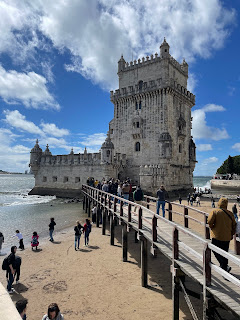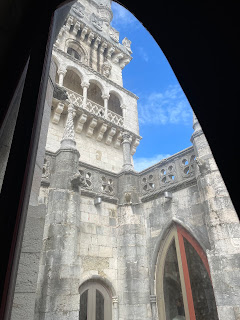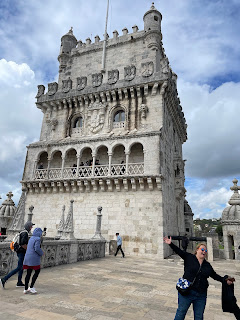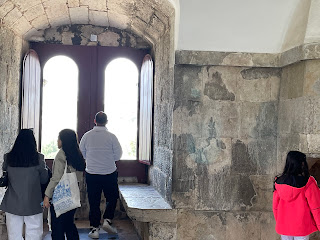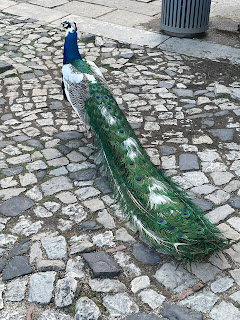Last night I had trouble falling asleep, so when I woke up and it was only 8:30, I went back to sleep. I woke up around 10:00 feeling much more refreshed! I had unpacked last night, so I showered and left, heading to Belém Tower. I was hoping to find a pick-up spot for my Lisboa card there. I took the bus, when I got to the bus stop, the stops on the chart did not match those on my phone. I wondered if it was the other side of the street, but there was no bus stop/shelter there. I then asked a man who did not speak English, but I showed my phone, saying the bus and destination. He led me across the street and told me "aqui" which means here, I repeated and he said "si". Then a teenager joined me at the spot, he was also taking the bus, and when the bus approached, he went out to the street and hailed it. So I was on my way! I got off at the right spot and walked to the destination.
Luckily, there was a Lisboa card desk there, but the employee wouldn't be there until 2:00, so I had to wait. I walked around. The tower was originally built in the 16th century to defend Lisbon from enemy ships. It is built at the entrance to the Tagus River. In the 17th century, it began use as a customs control point. It also served early on to mark the beginning of voyages for sailors and their last sight of land. It was also a state prison before becoming a customs port. After being used as a customs port, it was a telegraph station and later a lighthouse. It is considered to be one of the best examples of Manuelino style architecture with distinctive Moorish features such as ornately decorated turrets.
 |
| Buildings covered in tile |
 |
| A man replacing the sidewalk cobblestones |
 |
| I just like this building |
 |
| There's the tower! |
 |
| a model of the tower |
The tower is at the edge of the ocean, so it was windy and chilly. I was wearing a t-shirt, capris, and sandals, glad that I had taken my jacket as well. I went to a little cafe nearby over the water and ordered a sandwich to eat on the deck. Eventually it was 2:00, so I went to get my card and they gave me an entrance ticket to Belém as that was covered by the ticket. Then to get in line for the hour long wait to get in. Once I got in there, I appreciated that they only let a certain number of people in at a time, but it was a long wait. Especially with the person behind me who did not understand personal space and was often standing next to and slightly ahead of me instead of behind me and her husband standing too close behind me--that was annoying. The high tide mark showed at a level above where we were waiting in line.
 |
| going over the drawbridge |
 |
| the view from the cannon window |
 |
| ready for the shot, sir! |
 |
| main floor courtyard |
Going in you proceed over the drawbridge and out onto the main terrace. There were cannons placed in front of windows along all of the walls. Then up to the first floor of the tower-called the Governor's Room. It has an octogonal outlet of the system they were using to capture and store rainwater. It was primarily used for customs inspections and the collecting of taxes.
 |
| Above the main terrace area, outside the tower proper |
 |
| bad selfie--windy and chilly |
 |
| corner towers |
 |
| the tower |
 |
| looking down on the first floor courtyard |
 |
| part of system to capture and save rainwater |
 |
| a "secret" passage |
Then up a narrow spiral staircase (total of 93 steps) to the 2nd floor King's Room. There still exists a recessed fireplace built into the wall that suggests palatial comfort. It leads to a a loggia, from which you can watch ships arriving and setting sail as well as three bay windows. This room has a groin-vaulted ceiling.
 |
| conversation seating on loggia |
 |
| loggia |
 |
| ceiling of loggia |
 |
| groin-vaulted ceiling of King's room |
 |
| fireplace |
Next the 3rd floor Audience Room with several windows, including benches by the windows called conversation seats. There is also a fireplace in this room as well. Same ceiling as the King's Room.
And finally, the fourth floor chapel. It is the most architecturally complex of the rooms due to the ribbed vaulted ceiling that springs from corbels. There are many stone carvings referring to the power of King Manuel.
 |
| Nature motifs in carving |
Then I walked back out and headed back to the bus stop. The area around the Tower was planted with specific trees and plants and has many walking paths as well.
 |
| One of the balconies from the outside of the tower |
 |
| the loggia |
 |
| more nature motifs |
 |
the drawbridge works, also where hot oil is poured
down from if the enemies get that far |
 |
| Walking out over the drawbridge |
 |
| Where the secret passage led to |
 |
Not my family, but they wouldn't leave and I wanted a pic
before I left |
 |
| The grounds surounding the Tower |
I had to walk quite a ways to get to the correct bus to go to the Castle. When I got on the bus, many people got in at the same time. I was standing, squeezed in against a window in a wheelchair space. At the next stop, there was an even larger crowd. The driver told everyone standing in the aisle to move toward the back of the bus. I was hemmed into a tiny place by two strollers. At the next stop, we squeezed a few more passengers on but then couldn't fit anymore and had to leave them for the next bus.
 |
| Reminds me of what a religious city this is |
 |
These pics are what used to be a church and are now a
maritime museum |
I got off at the correct station despite the sign on the bus not telling what stop was next and some of the stops not being labeled. Then walked up some very steep streets to reach the Castelo de São Jorge (Castle of St. George) on the highest point in the city. It was a strategic point for many groups over the years because of the vantage point and because of a steep drop off on one side of the hill that kept enemies from invading on that side. Inside the gate are gardens and terraces that are being restored. As I was walking around, there were horrible cries--the peacocks that live there.
 |
| The entrance to the castle |
 |
| gardens |
 |
| From the grounds |
 |
| An old wall? |
 |
| an archological site |
 |
| abandoned doorway |
 |
| The peacocks |
I was reading in one area that as each new group/religion invaded and took over the castle and the city, the old residents just moved to the outskirts of the city as the new residents filled in the central area--it was just expected and was what made the city grow outward. They are still working on excavating the grounds of the castle. They have found areas from the Iron Age inhabitants, the Moors (Muslims), and the Catholics. There were a few more minor settlements as well.
 |
Old drawings of the castle and city over time with
different groups in charge |
 |
Some old tile from the museum of pottery, coins, and cooking vessels.
Evidently there was a law back then that the metal of the coin had to be
equal in value to what was being purchased which led to a lot of coins
being cut up into pieces. |
 |
| More of the grounds near the archological site |
 |
| Lots of castle walls to walk on |
 |
| The current archeological site, looking at the areas that many of the past inhabitants lived. |
After the castle, I walked around the small streets nearby and found a square with a shop selling sandwiches. So I bought some cod rolls and pastries with an orange sauce and some meat inside as well as some lemonade to eat out in the square. It started to sprinkle as I found a bench to sit on. A peacock came up to me, wanting food, but I had to keep shooing it away since I knew that people food is not good for wild animals for many reasons. Eventually a crowd formed taking pictures and laughing everytime I shooed him away! Eventually I was done without getting pecked at and decided to walk back to my hostel instead of taking the bus since it was only a few miles.
 |
| "My" peacock |
 |
| a street artist playing an adapted steel pan |
 |
an elementary school
|
When I got to my hostel, I realized that my flight was at 7:30 and I had to be there early and use my Lisboa card to take the bus (which was scheduled to take over an hour). Packed up all I could. Yikes, set my alarm for 4:00, hope I wake up in time! And get at least some sleep.














































